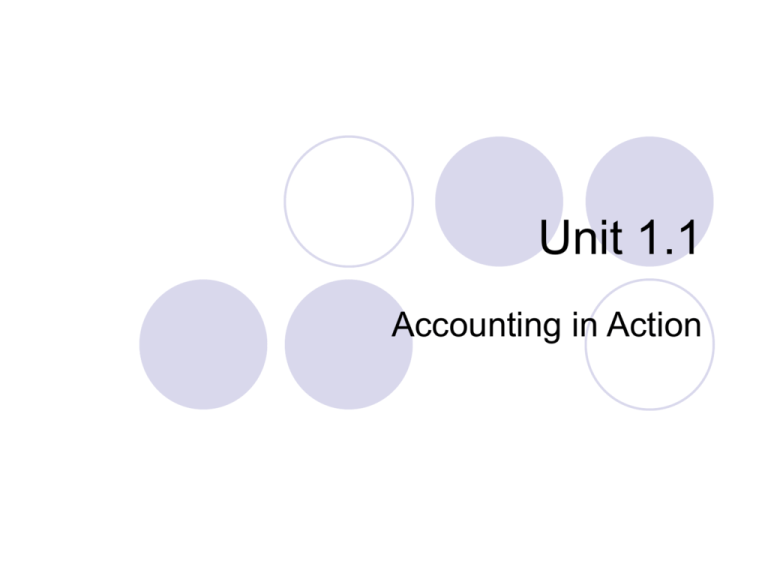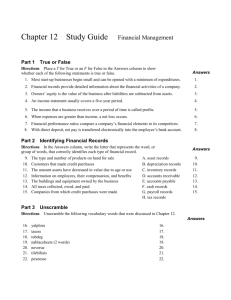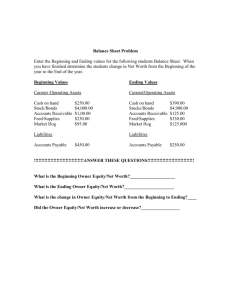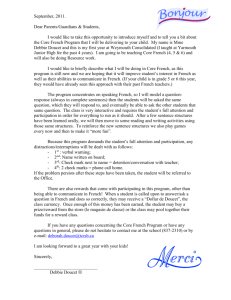Ch01
advertisement

Unit 1.1 Accounting in Action The Accounting Process Identification Selecting those events that are considered evidence of economic activity Recording Maintained as a permanent history of the financial activities of the business Communicating Through the preparation and distribution of financial statements Questions Asked by Internal Stakeholders Is cash sufficient to pay bills? Can we afford to give employees pay raises this year? What is the cost of manufacturing each unit of product? Which product line is the most profitable? Questions Asked by External Stakeholders Is the company earning satisfactory income? How does the company compare in size and profitability with its competitors? Will the company be able to pay its debts as they come due? Bookkeeping and Accounting Distinguished Accounting 1. Includes bookkeeping 2. Also includes much more Bookkeeping 1. Involves only the recording of economic events 2. Is just one part of accounting The Accounting Profession Public accountants offer their expertise to the general public through the services they perform. Private accountants are employees of individual companies and are involved in a number of activities, including cost and tax accounting, systems, and internal auditing. Not-for-profit accounting includes reporting and control for government units, foundations, hospitals, labour unions, colleges/universities, and charities. Generally Accepted Accounting Principles Primarily established by the Canadian Institute of Chartered Accountants (CICA) Cost Principle The cost principle dictates that assets are recorded at their cost. Cost is the value exchanged at the time something is acquired. Cost is used because it is both relevant and reliable. Assumptions 1. Going Concern - assumes organization will continue into foreseeable future. 2. Monetary Unit - only transaction data that can be expressed in terms of money is included in the accounting records. 3. Economic Entity - includes any organization or unit in society. 4. Objectivity – being able to independently verify information the same way every time. Business Enterprises A business owned by one person is generally a proprietorship (owner’s equity). A business owned by two or more persons associated as partners is a partnership (partners’ equity). A business organized as a separate legal entity under corporation law and having ownership divided into transferable shares is called a corporation (shareholders’ equity). Basic Accounting Equation Assets = Liabilities + Owner’s Equity Assets Assets are resources owned by a business. They are things of value used in carrying out such activities as production and exchange. Liabilities Liabilities are claims against assets. They are existing debts and obligations. Owner’s Equity Owner’s Equity is equal to total assets minus total liabilities. Owner’s Equity represents the ownership claim on total assets. Subdivisions of Owner’s Equity: 1. Capital 2. Drawings 3. Revenues 4. Expenses Investment by the Owner Investments by owner are the assets put into the business by the owner Often called Capital These investments in the business increase owner’s equity. Drawings Drawings are withdrawals of cash or other assets by the owner for personal use. Drawings decrease total owner’s equity. Revenues Revenues are the gross increases in owner’s equity resulting from business activities entered into for the purpose of earning income. Revenues may result from sale of merchandise, performance of services, rental of property, or lending of money. Revenues usually result in an increase in an asset. Expenses Expenses are the decreases in owner’s equity that result from operating the business. Expenses are the cost of assets consumed or services used in the process of earning revenue. Examples of expenses include utility expense, rent expense, and supplies expense. Increases and Decreases in Owner’s Equity Increases Investments by Owner Revenues Decreases Owner’s Equity Withdrawals by Owner Expenses Transaction Analysis Marc Doucet decides to open a computer programming service. BANK Softbyt e Transaction 1 On September 1, he invests $15,000 cash in the business, which he names Softbyte. Trans. # (1) Assets Cash 15,000 Supplies = Liabilities + Owner's Equity Accounts M. Doucet, Equipment Payable Capital = 15,000 Investment There is an increase in the asset Cash, $15,000, and an equal increase in the owner’s equity, M. Doucet, Capital, $15,000. Transaction 2 Softbyte purchases computer equipment for $7,000 cash. Trans. # (2) Balance Assets Cash Supplies 15,000 (7,000) 8,000 + = Liabilities + Owner's Equity Accounts M. Doucet, Equipment Payable Capital 15,000 Investment 7,000 7,000 = 15,000 Cash is decreased $7,000, and the asset Equipment is increased $7,000. Transaction 3 Softbyte purchases computer paper and supplies expected to last several months from Chuah Supply Company for $1,600 on account. Trans. # Balance (3) Balance Assets Cash 8,000 8,000 8,000 == Liabilities ++ Owner's Owner's Equity Accounts M. Accounts M. Doucet, Supplies Equipment Payable Capital Equipment 7,000 15,000 7,000 15,000 1,600 1,600 + 1,600 + 7,000 = 1,600 + 15,000 The asset Supplies is increased $1,600, and the liability Accounts Payable is increased by the same amount. Transaction 4 Softbyte receives $1,200 cash from customers for programming services it has provided. Trans. # Balance (4) Balance Assets = Liabilities + Owner's Equity Accounts M. Doucet, Cash Payable Capital Supplies Equipment 1,600 7,000 1,600 8,000 15,000 1,200 1,200 Service Revenue 9,200 + 1,600 + 7,000 = 1,600 + 16,200 Cash is increased $1,200, and M. Doucet, Capital is increased $1,200. Transaction 5 Softbyte receives a bill for $250 for advertising its business but pays the bill on a later date. Trans. # Balance (5) Balance Assets = Liabilities + Owner's Owner's Equity Accounts M. Doucet, Cash Supplies Equipment Payable Capital 9,200 + 1,600 7,000 1,600 16,200 1,600 + 7,000 = 1,600 + 16,200 250 (250) Advertising Expense 9,200 1,600 7,000 1,850 15,950 Accounts Payable is increased $250, and M. Doucet, Capital is decreased $250. Transaction 6 Softbyte provides programming services of $3,500 for customers and receives cash of $1,500, with the balance payable on account. Trans. ## Balance Balance (6) Balance Cash 9,200 9,200 1,500 10,700 Assets == Liabilities Liabilities ++ Owner's Owner's Equity Account Account Accounts Accounts M. M. Doucet, Doucet, Receivable Receivable Supplies Supplies Equipment Equipment Payable Payable Capital Capital ++ 00 ++ 1,600 1,600 ++ 7,000 7,000 == 1,850 1,850 15,950 15,950 2,000 3,500 Service Revenue 2,000 1,600 7,000 1,850 19,450 Cash is increased $1,500; Accounts Receivable is increased $2,000; and M. Doucet, Capital is increased $3,500. Transaction 7 Expenses paid in cash for September are store rent, $600, salaries of employees, $900, and utilities, $200. Trans. # Balance (7) Balance Cash 10,700 (600) (900) (200) 9,000 + Assets Account Receivable Supplies 2,000 1,600 2,000 + = Liabilities + Owner's Equity Accounts M. Doucet, Equipment Payable Capital 7,000 1,850 19,450 (600) Rent Exp. (900) Salaries Exp. (200) Utilities Exp. 1,600 + 7,000 = 1,850 + 17,750 Cash is decreased $1,700 and M. Doucet, Capital is decreased the same amount. Transaction 8 Softbyte pays its advertising bill of $250 in cash. Trans. # Balance Balance (8) Balance Cash Cash 9,000 9,000 (250) 8,750 + AccountAssets Account Receivable Supplies Receivable Supplies 2,000 1,600 2,000 1,600 2,000 + 1,600 + Equipment Equipment 7,000 7,000 7,000 = Liabilities Owner's Equity Accounts + M. Doucet, Accounts M.Capital Doucet, Payable Payable Capital 1,850 17,750 1,850 17,750 (250) = 1,600 + 17,750 Cash is decreased $250 and Accounts Payable is decreased the same amount. Transaction 9 The sum of $600 in cash is received from customers who have previously been billed for services in Transaction 6. Trans. # Balance (9) Balance Assets = Liabilities + Owner's Equity Account Accounts M. Doucet, Cash Receivable Supplies Payable Capital Equipment 8,750 + 2,000 + 1,600 + 7,000 = 1,600 + 17,750 600 (600) 9,350 + 1,400 + 1,600 + 7,000 = 1,600 + 17,750 Cash is increased $600 and Accounts Receivable is decreased by the same amount. Transaction 10 Marc Doucet withdraws $1,300 in cash from the business for his personal use. Trans. # Balance (10) Balance Assets Cash 9,350 (1,300) 8,050 = Liabilities Owner's Liabilities ++ Owner's Equity Account Accounts M. Accounts M. Doucet, Doucet, Receivable Supplies Equipment Payable Capital Equipment Payable Capital 1,400 1,600 7,000 1,600 17,750 1,600 7,000 1,600 17,750 (1,300) Doucet, Drawings + 1,400 + 1,600 + 7,000 = 1,600 + 16,450 Cash is decreased $1,300 and M. Doucet, Capital is decreased by the same amount. Financial Statements After transactions are identified, recorded, and summarized, four financial statements are prepared from the summarized accounting data: 1. An income statement presents the revenues and expenses and resulting net income or net loss of a company for a specific period of time. 2. A statement of owner’s equity summarizes the changes in owner’s equity for a specific period of time. Financial Statements (continued) In addition to the income statement and statement of owner’s equity, two additional statements are prepared: 3. A balance sheet reports the assets, liabilities, and owner’s equity of a business enterprise at a specific date. 4. A cash flow statement summarizes information concerning the cash inflows (receipts) and outflows (payments) for a specific period of time. The notes are an integral part of the financial statements. Relationship Between Financial Statements SOFTBYTE Income Statement For the Month Ended September 30, 2008 Revenues Service revenue $ 4,700 Expenses Salaries expense $ 900 Rent expense 600 Advertising expense 250 Utilities expense 200 Total expenses 1,950 Net income $ 2,750 Net income of $2,750 shown on the income statement is added to the beginning balance of owner’s capital in the statement of owner’s equity. Relationship Between Financial Statements SOFTBYTE Statement of Owner's Equity For the Month Ended September 30, 2008 M. Doucet, Capital, September 1 Add: Investments Net income Less: Drawings M. Doucet, Capital September 30 $ $ 15,000 2,750 - 17,750 $ 17,750 1,300 $ 16,450 Net income of $2,750 is carried forward from the income statement to the statement of owner’s equity. The owner’s capital of $16,450 at the end of the reporting period is shown as the final total of the owner’s equity column of the Summary of Transactions Relationship Between Financial Statements Owner’s capital of $16,450 at the end of the reporting period – shown in the statement of owner’s equity – is also shown on the balance sheet. Cash of $8,050 on the balance sheet is reported on the cash flow statement. SOFTBYTE Balance Sheet September 30, 2008 Assets Cash Accounts receivable Supplies Equipment Total assets $ 8,050 1,400 1,600 7,000 $ 18,050 Liabilities and Owner's Equity Liabilities Accounts payable Owner's Equity M. Doucet, Capital Total liabilities and owner's equity $ 1,600 16,450 $ 18,050 Relationship Between Financial Statements Cash of $8,050 on the balance sheet and cash flow statement is shown as the final total of the cash column of the Summary of Transactions SOFTBYTE Cash Flow Statement For the Month Ended September 30, 2008 Cash flows from operating activities Cash receipts from customers $ 3,300 Cash payments to suppliers and employees (1,950) Net cash provided by operating activities Cash flows from investing activities Purchase of equipment $ (7,000) Net cash used by investing activities Cash flows from financing activities Investments by owner $ 15,000 Drawings by owner (1,300) Net cash provided by financing activities Net increase in cash Cash, September 1 Cash, September 30 $ 1,350 (7,000) 13,700 $ 8,050 $ 8,050







